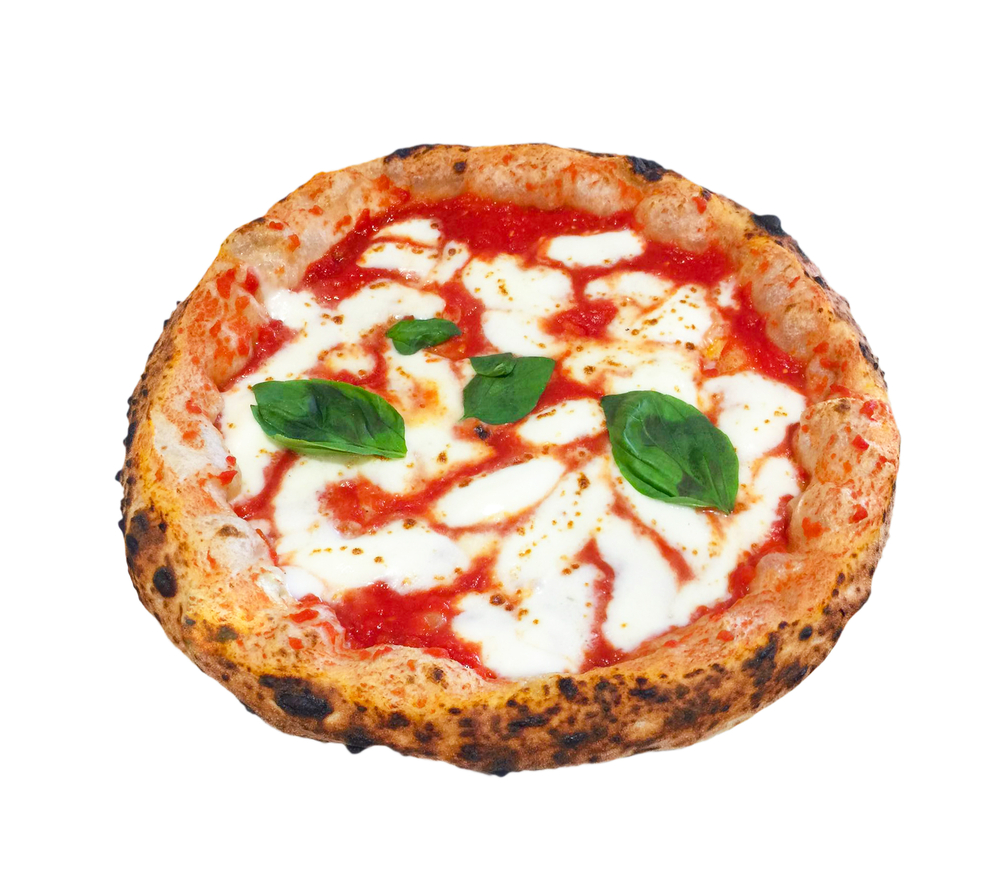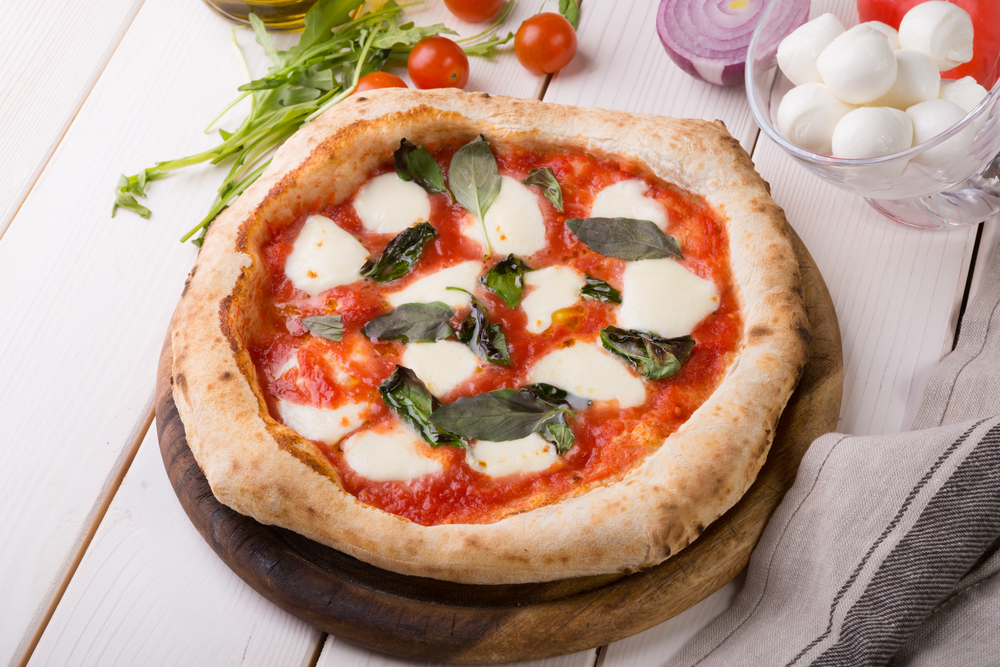Two of the most popular types of this delectable dish are the Neapolitan and Margherita variants of pizza. We frequently have to make a difficult decision while ordering pizza.

Although they appear to be similar, the two have substantial differences, and choosing the right one can greatly impact your pizza-eating experience.
In this essay, we’ll investigate various variations in order to help you decide which is ideal for you.
Margherita pizza has a thicker, doughier crust, whereas Neapolitan pizza is renowned for its crispy, thin crust. Each style of pizza is cooked differently, which can be observed in the differences in the crust.
Neapolitan pizzas have a thinner crust because they are cooked for a shorter period of time at a higher temperature.
Margherita pizzas, on the other hand, have a thicker crust since they are cooked for a longer period of time at a lower temperature. Both dishes have different toppings.
Although there are numerous toppings and styles for Neapolitan pizza, Pizza Margherita is by far the most popular. The typical ingredients for pizza Margherita are tomatoes, sliced mozzarella, basil, and extra virgin olive oil.
Understanding the distinctions between Neapolitan and Margherita pizza might help you make an informed choice the next time you order a pizza, whether you are a pizza connoisseur or a casual pizza enthusiast.
We will go into more detail on the toppings, dough, and other characteristics that set these two styles of pizza apart in the sections that follow.
Origins
When it comes to Neapolitan and Margherita pizzas, it’s important to understand their origins. Neapolitan pizza has its roots in Naples, Italy, around the 1700s and is credited as the birthplace of pizza.

Modern pizza evolved from similar flatbread dishes in Naples, Italy, in the 18th or early 19th century. The pizza was initially a simple dish made with tomatoes, garlic, and oil on a flatbread, but it quickly became a staple food in Naples.
In 1889, Raffaele Esposito, a famous Neapolitan pizza maker, created the Pizza Margherita in honor of Queen Margherita of Savoy. The queen wanted to try the local pizza, and Esposito made three different pizzas for her to try.
The Pizza Margherita, made with tomatoes, mozzarella cheese, and basil, was her favorite, and it became an instant hit. The Pizza Margherita was named after the queen and is still one of the most popular pizza varieties in the world.
The Pizza Margherita is also famous for its connection to the Italian flag. The colors of the pizza toppings – red tomatoes, white mozzarella cheese, and green basil – represent the colors of the Italian flag.
The Pizza Margherita quickly became a symbol of Italian cuisine and culture, and it remains one of the most iconic pizza varieties in the world.
Understanding the origins of Neapolitan and Margherita pizzas is essential to appreciate these classic Italian dishes properly.
The Neapolitan pizza has its roots in Naples, Italy, around the 1700s, while the Pizza Margherita was created in 1889 by Raffaele Esposito in honor of Queen Margherita of Savoy.
The Pizza Margherita is also famous for its connection to the Italian flag, making it a symbol of Italian cuisine and culture.
Ingredients
When it comes to Neapolitan and Margherita pizzas, the ingredients used are crucial in achieving the distinct flavors and textures that set them apart.

In this section, we’ll take a closer look at the key ingredients that make up these beloved pizzas.
Crust
Both Neapolitan and Margherita pizzas feature a thin, crispy crust. However, there are some differences in the dough used to make each. Neapolitan pizza dough is made with only four ingredients: flour, water, salt, and yeast.
The dough is left to rise for several hours before being shaped by hand and cooked in a wood-fired oven at high temperatures for just 60-90 seconds. This results in a crust that is slightly charred on the outside and soft and chewy on the inside.
Margherita pizza crust, on the other hand, is typically thicker and doughier than Neapolitan crust. The dough is made with similar ingredients, but it may contain additional sugar or olive oil to give it a slightly sweeter flavor.
The crust is also cooked for a longer time at a lower temperature, resulting in a more evenly cooked and slightly crispier texture.
Sauce
The tomato sauce used on both Neapolitan and Margherita pizzas is typically made with San Marzano tomatoes, which are known for their sweet and tangy flavor. The sauce is seasoned with garlic, oregano, and a drizzle of extra virgin olive oil to give it a rich, savory taste.
Cheese
Fresh mozzarella is the cheese of choice for both Neapolitan and Margherita pizzas. However, there are some variations in the type of mozzarella used.
Neapolitan pizza traditionally features mozzarella di bufala campana, which is made from the milk of water buffalo and has a creamier texture and slightly tangy flavor.
Margherita pizza, on the other hand, typically uses fior di latte di agerola, which is made from cow’s milk and has a milder flavor.
Toppings
While Neapolitan pizza is often served with a variety of toppings, Margherita pizza is typically made with just a few simple ingredients.
The classic Margherita pizza features sliced fresh tomatoes, fresh basil leaves, and a sprinkle of Parmesan cheese. Some variations may also include sliced garlic or a drizzle of olive oil.
Overall, the key ingredients used in Neapolitan and Margherita pizzas are what gives them their distinct flavor profiles.
Whether you prefer the simplicity of a Margherita pizza or the bold flavors of a Neapolitan pizza with toppings, there’s no denying that both are delicious in their own right.
Neapolitan Pizza
When it comes to Neapolitan-style pizza, we know that it originated in Campania, Italy. This type of pizza is known for its thin crust, which is crispy on the outside and chewy on the inside.

The crust is made with flour, water, yeast, and salt, and is left to rise for at least 8 hours. This long rise time is what gives Neapolitan pizza its characteristic texture.
One of the key ingredients in Neapolitan pizza is San Marzano tomatoes. These tomatoes are grown in the volcanic soil of Mount Vesuvius and are known for their sweet and tangy flavor.
They are used to make the sauce that goes on top of the pizza, which is then topped with fresh mozzarella cheese and fresh basil.
Neapolitan pizza is traditionally cooked in a wood-burning oven, which gives it a unique flavor and texture. The oven is heated to a temperature of around 900°F, and the pizza is cooked for just 60-90 seconds.
This high heat and short cooking time result in a pizza that is charred on the edges and soft in the middle.
If you’re interested in learning how to make Neapolitan pizza, you might consider attending a pizza school. There are many schools around the world that offer courses in pizza-making, and some of them specialize in Neapolitan-style pizza.
These courses can teach you everything from how to make the dough to how to cook the pizza in a wood-burning oven.
When it comes to nutrition, Neapolitan pizza is relatively low in protein content compared to other types of pizza.
However, it is a good source of calcium, thanks to the cheese that is used as a topping. The long rise time of the dough also allows it to develop more complex flavors and makes it easier to digest.
Overall, Neapolitan pizza is a delicious and unique style of pizza that is beloved by pizza lovers around the world.
Whether you’re making it at home or enjoying it at a pizzeria, there’s no denying the appeal of this classic Italian dish.
Margherita Pizza
When it comes to pizza, Margherita is one of the most popular types of pizza in the world. This classic pizza is named after Margherita of Savoy, the Queen of Italy.

It is believed that the pizza was created in 1889 by chef Raffaele Esposito of the Brandi pizzeria, in honor of the Queen.
The pizza was made with ingredients that represented the colors of the Italian flag: red tomatoes, white mozzarella cheese, and green basil.
Margherita pizza is a traditional Neapolitan pizza that is made with a thick, doughy crust. The crust is usually cooked until it is crispy on the outside and soft on the inside.
The sauce is made with San Marzano tomatoes, which are known for their sweet flavor and low acidity.
The cheese used is typically fresh mozzarella cheese, which is sliced and placed on top of the sauce. The pizza is then topped with fresh basil leaves and a drizzle of olive oil.
One of the key ingredients in Margherita pizza is fresh basil. The basil leaves are added to the pizza just before it is served, giving it a fresh and aromatic flavor.
The basil also adds a pop of green color to the pizza, making it visually appealing.
Another important element of Margherita pizza is the crust. The crust is made with a combination of flour, water, yeast, and salt.
The dough is left to rise for several hours, which gives it a light and airy texture. The crust is then baked in a wood-fired oven, which gives it a smoky flavor and a crispy texture.
In terms of cheese, Margherita pizza is typically made with fresh mozzarella cheese. The cheese is sliced and placed on top of the tomato sauce, which allows it to melt and become gooey when the pizza is cooked.
Some people also like to add Parmesan cheese to their Margherita pizza for an extra flavor boost.
Overall, Margherita Pizza is a classic pizza that is loved by many people around the world. Its simple yet delicious ingredients make it a favorite among pizza lovers everywhere.
Comparison
When it comes to Neapolitan and Margherita pizzas, there are several factors to consider. In this section, we will compare the two pizzas based on taste, nutrition, and popularity.
Taste
Neapolitan pizza is known for its thin, crispy crust and minimal toppings. The sauce is made with San Marzano tomatoes, and the cheese is typically fresh mozzarella.
The pizza is cooked at a high temperature for a short period of time, resulting in a slightly charred crust.
Margherita pizza, on the other hand, has a thicker, doughier crust and is topped with sliced fresh mozzarella, tomato sauce, and fresh basil. The pizza is cooked at a lower temperature for a longer period of time, resulting in a softer crust.
Both pizzas have distinct flavors and textures. Neapolitan pizza has a slightly smoky flavor from the charred crust, while Margherita pizza has a sweeter flavor from the tomato sauce and fresh basil.
Nutrition
When it comes to nutrition, both Neapolitan and Margherita pizzas are relatively healthy options compared to other types of pizza. However, there are some differences to consider.
Neapolitan pizza has a thinner crust and fewer toppings, which means it is lower in calories and carbohydrates. However, it may not be as filling as Margherita pizza, which has a thicker crust and more toppings.
Margherita pizza is a good source of calcium, thanks to the fresh mozzarella cheese. It also contains some iron and protein from the tomato sauce and basil.
However, both pizzas can be high in sodium, depending on the amount of cheese and sauce used.
Popularity
Both Neapolitan and Margherita pizzas are popular choices around the world. Neapolitan pizza originated in Naples, Italy, and has been a staple in Italian cuisine for centuries.
Margherita Pizza was created in honor of Queen Margherita of Savoy in the late 19th century and has since become a classic pizza topping.
In recent years, Neapolitan pizza has gained popularity in the United States, thanks in part to the rise of artisanal pizza shops. Margherita pizza remains a popular choice for those who prefer a classic pizza with simple toppings.
Neapolitan and Margherita pizzas have their own unique flavors and textures, as well as nutritional benefits. The choice between the two ultimately comes down to personal preference.
Conclusion
After exploring the differences between Neapolitan and Margherita Pizza, we can confidently say that both styles have their unique characteristics and flavor profiles.
Neapolitan pizza has a light and airy crust with subtle flavors, while Margherita pizza has a thicker, more substantial crust with intense flavors.
When it comes to ingredients, both pizzas use similar ones such as San Marzano tomatoes, mozzarella cheese, and fresh basil.
However, Neapolitan pizza tends to use fewer toppings, while Margherita pizza can have additional toppings such as olives, mushrooms, and pepperoni.
In terms of preparation, Neapolitan pizza is cooked at a higher temperature for a shorter time, resulting in a thinner crust.
On the other hand, Margherita pizza is cooked at a lower temperature for a longer time, giving the dough more time to rise and resulting in a thicker crust.
Ultimately, the choice between Neapolitan and Margherita pizza comes down to personal preference. Some people may prefer the simplicity and subtlety of Neapolitan pizza, while others may enjoy the bold flavors and thicker crust of Margherita pizza.
Regardless of which style you prefer, both Neapolitan and Margherita pizza are classic Italian dishes that have stood the test of time.







Add comment